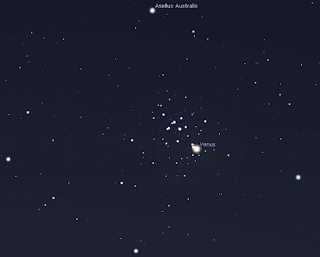Thursday, July 01, 2021
Venus in the Heart of the Beehive cluster (July 2-4, 2021)
| Evening twilight sky on Saturday, July 3 looking north-west as seen from Adelaide at 18:15 ACST (60 minutes after sunset). Venus is low above the horizon below Mars and is in front of the Beehive cluster. You will require binoculars to see this. Similar views will be seen throughout Australia at the equivalent local time (60 minutes after sunset, click to embiggen). | The approximate binocular view of Venus and the Beehive on Friday, July 2. Venus is on the edge of the Beehive. |
| The approximate binocular view of Venus and the Beehive on Saturday, July 3. Venus is in the heart of the Beehive. | The approximate binocular view of Venus and the Beehive on Sunday, July 4. Venus is once again on the edge of the Beehive. |
Over the next few days Brilliant Venus passes over the lovely Beehive Cluster (M44), a rather delightful open cluster. The highlight is on the Saturday, when Venus blazes in the heart of the cluster.
Although the cluster is notionally (just) visible to the unaided eye, the proximity to the horizon muk and bright Venus means you will need binoculars to see it. Especially on Saturday when Venus is in the centre of the cluster, which will drown out all but the dimmer members of the cluster. This will also be good in medium power telescope eyepieces (high power eyepieces will miss most of the cluster).
The best time to look will be be around an hour after sunset (nautical twilight), balancing the not complete darkness of the sky against the height above the horizon. Venus is obvious as the brightest object above the north-west horizon, just point your binoculars at venus and the cluster will be in view too.
If you have a level uncluttered horizon then you should be able to follow Venus and the Beehive until the sky is fully dark. However, horizon murk may dim everything cancelling out the dark advantage..
Labels: Beehive cluster, binocular, Venus







 Click to read about or order
Click to read about or order Click to read about or order
Click to read about or order Click to read about or order
Click to read about or order Click to read about or order
Click to read about or order




